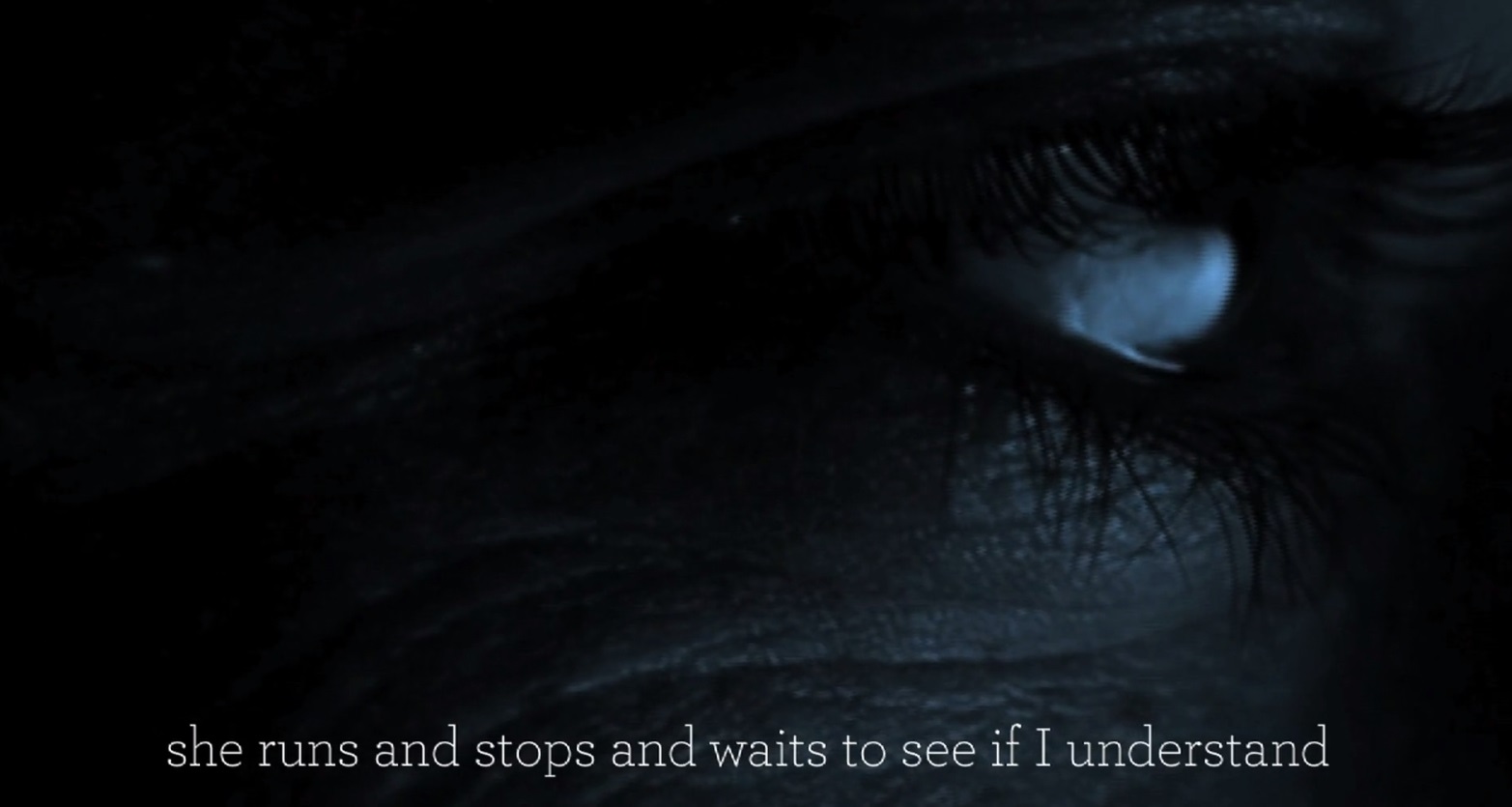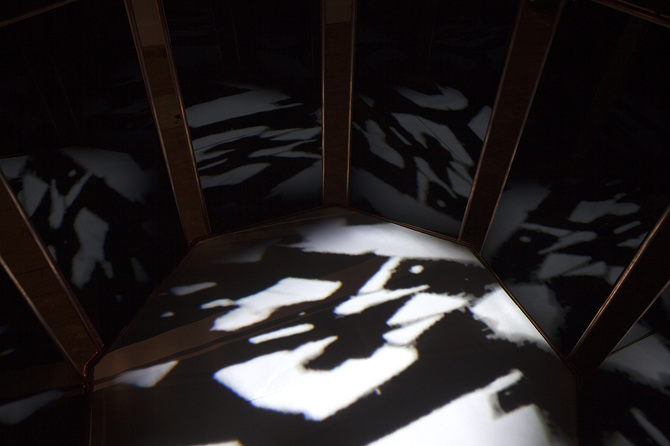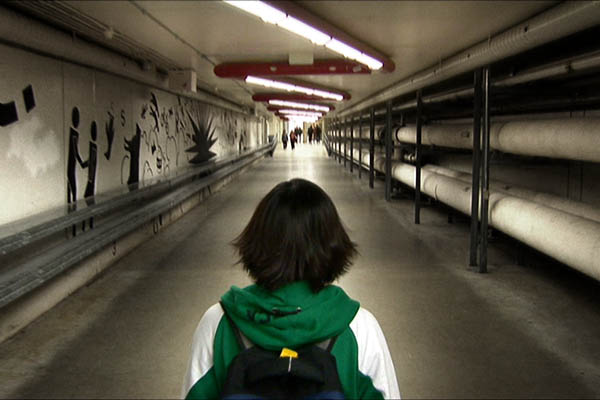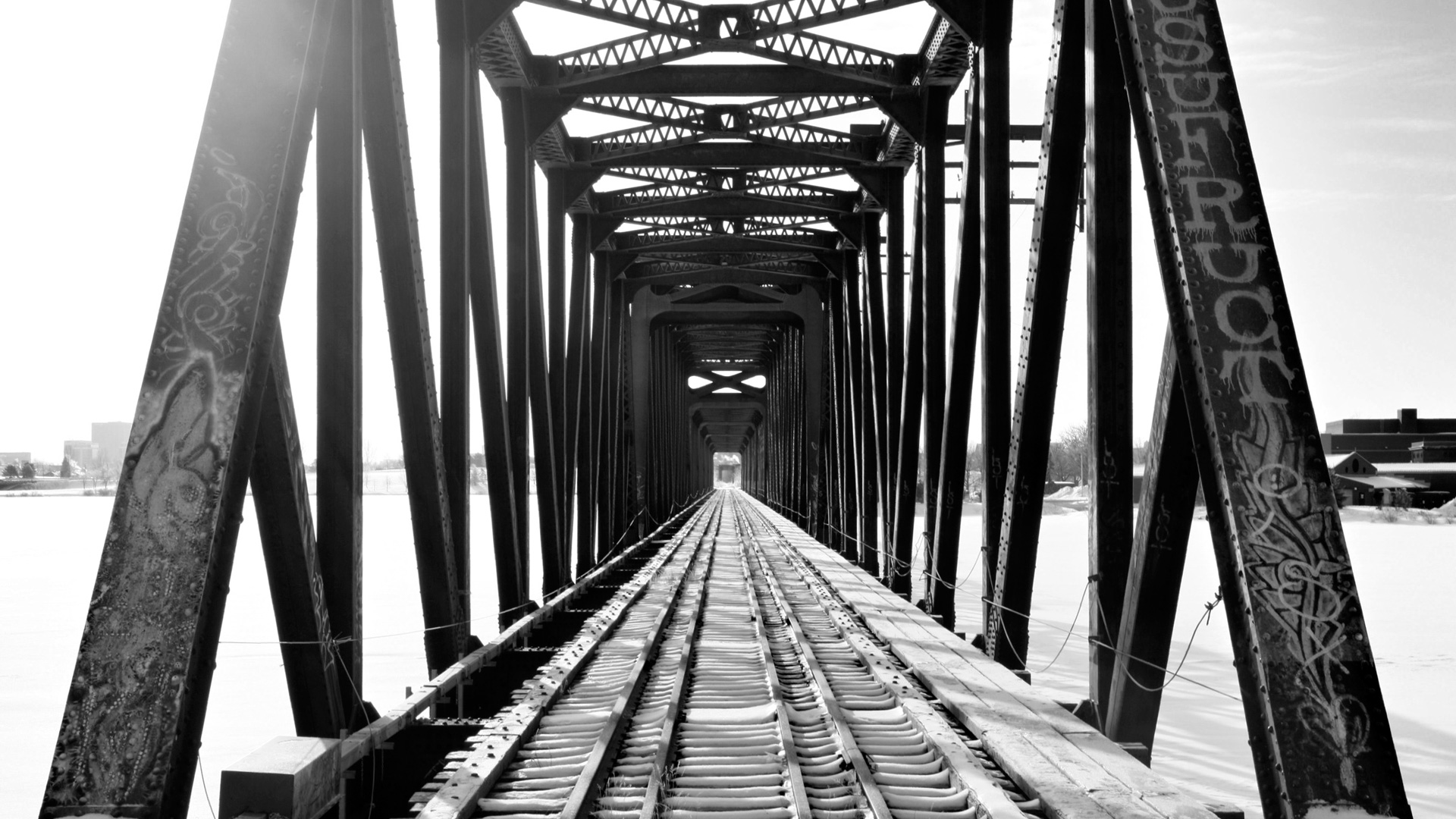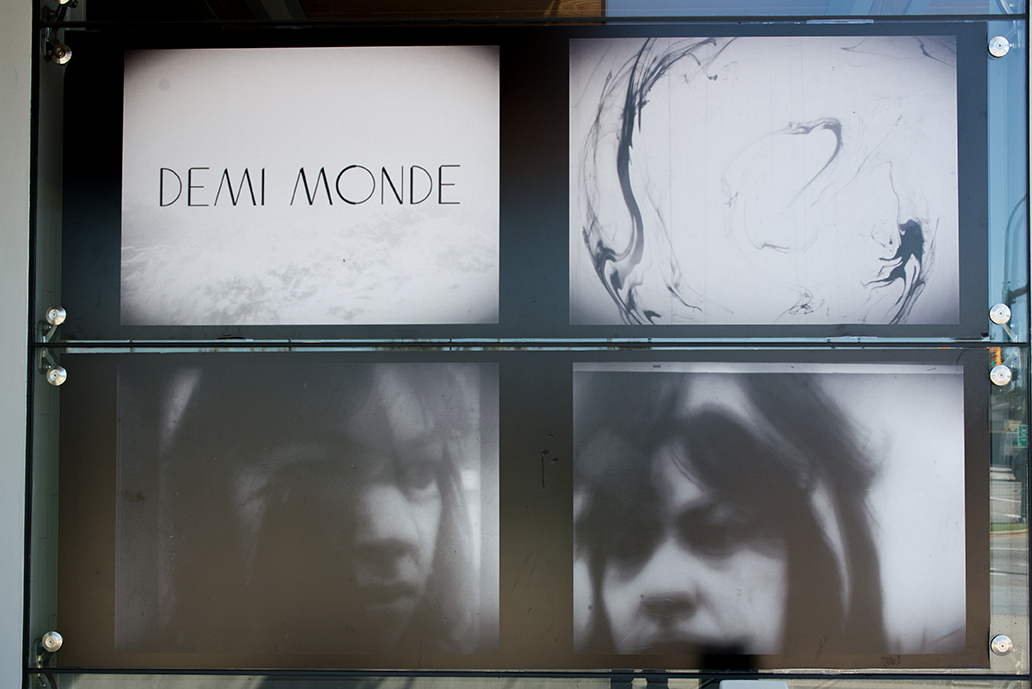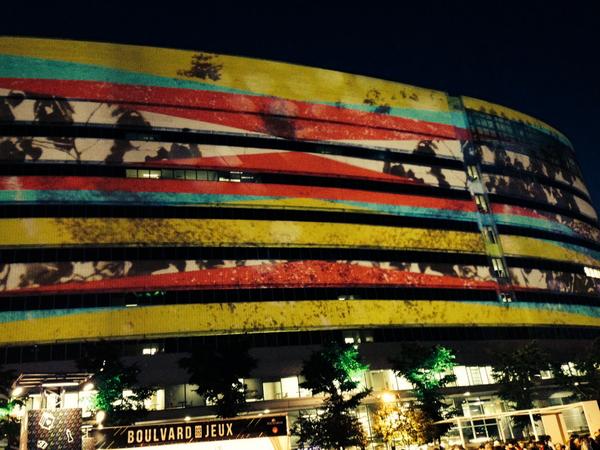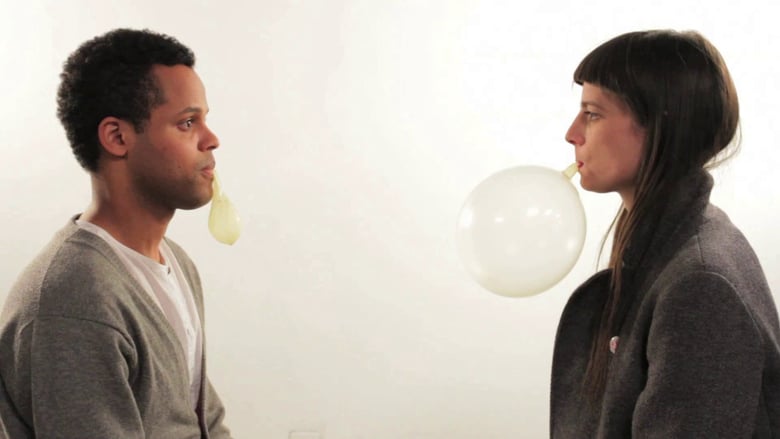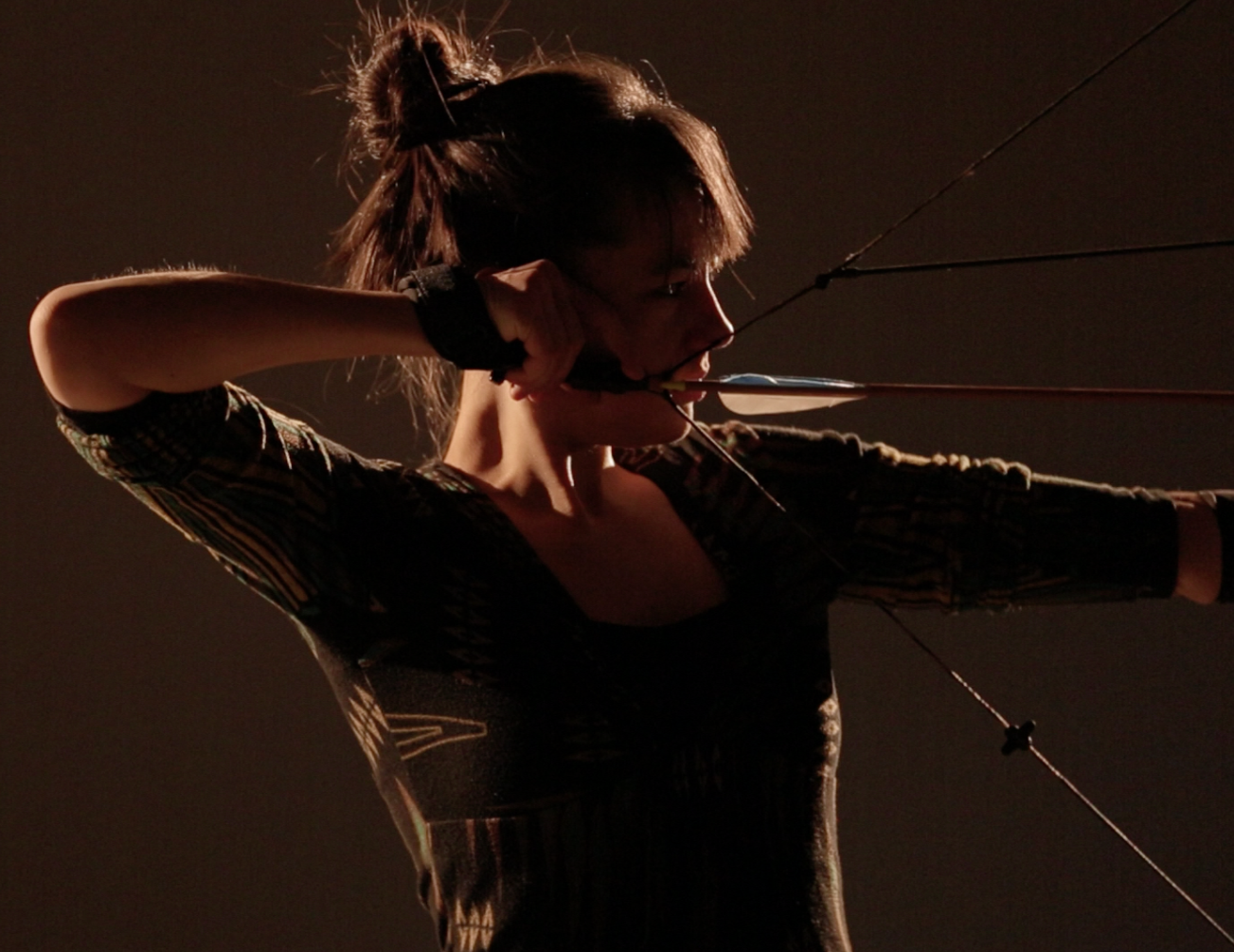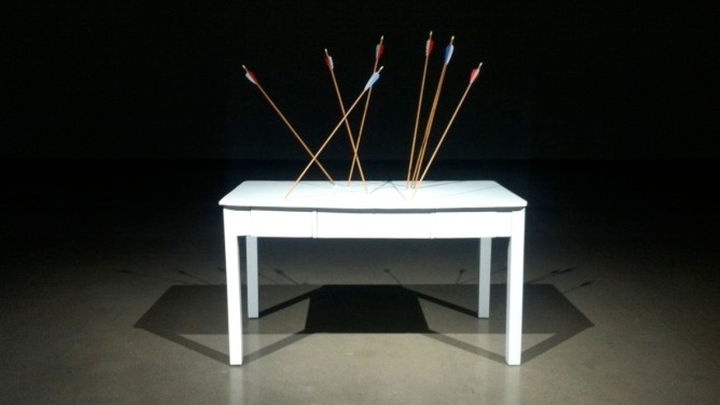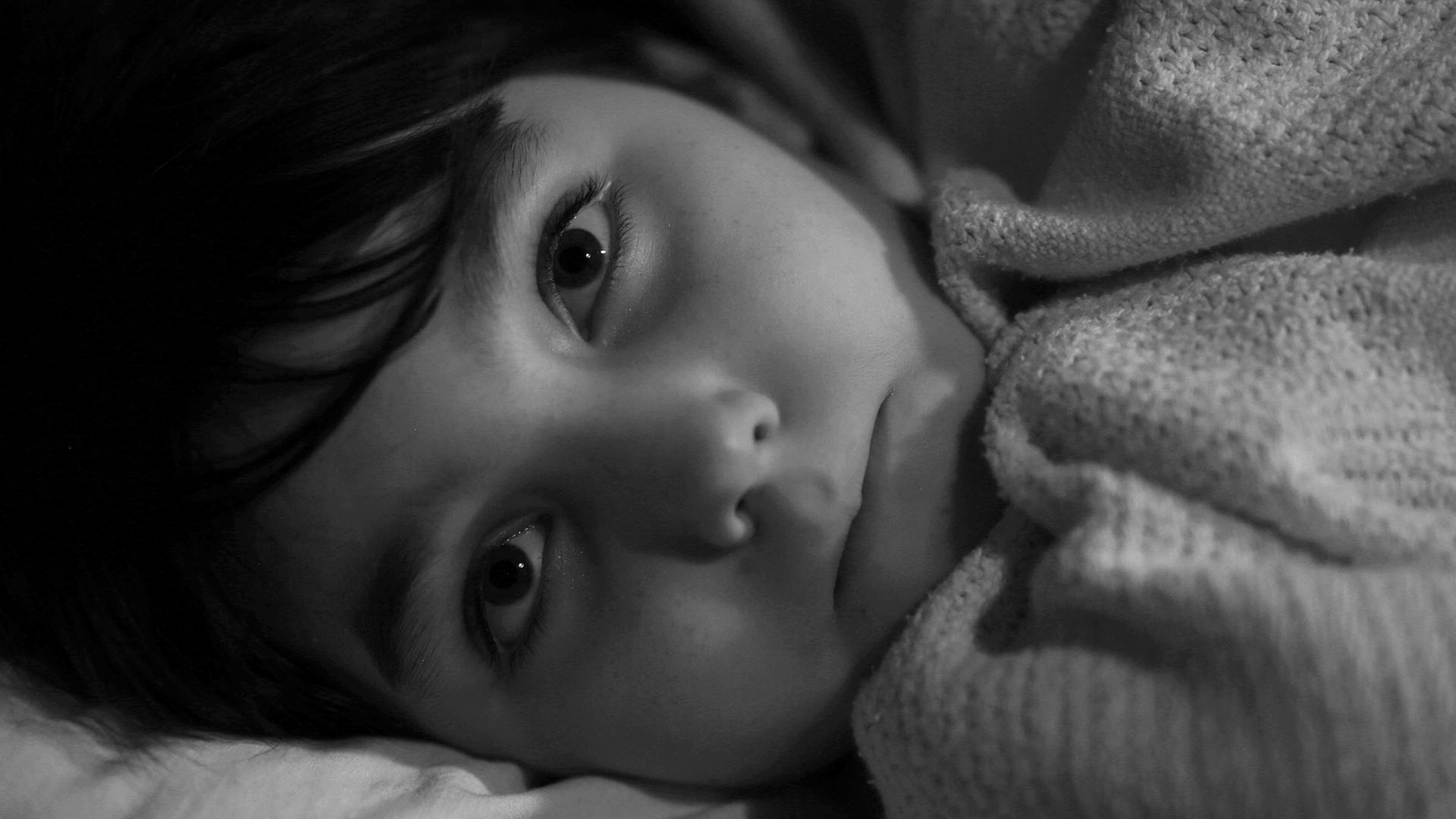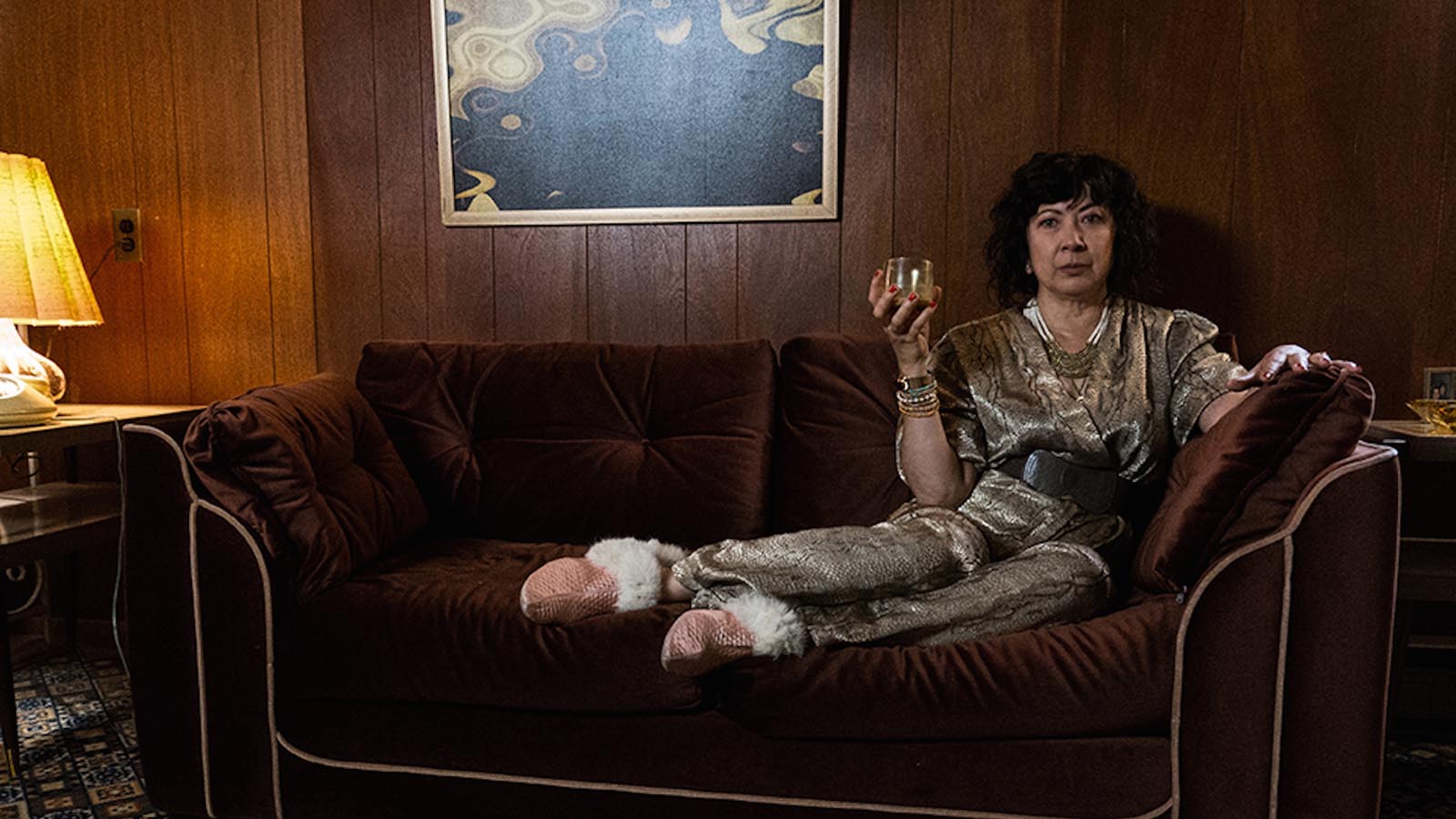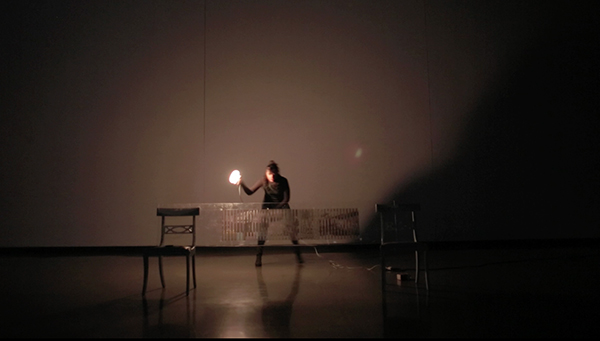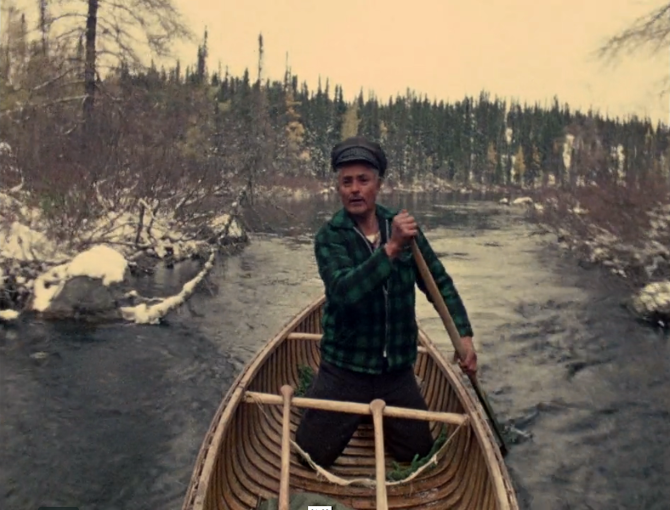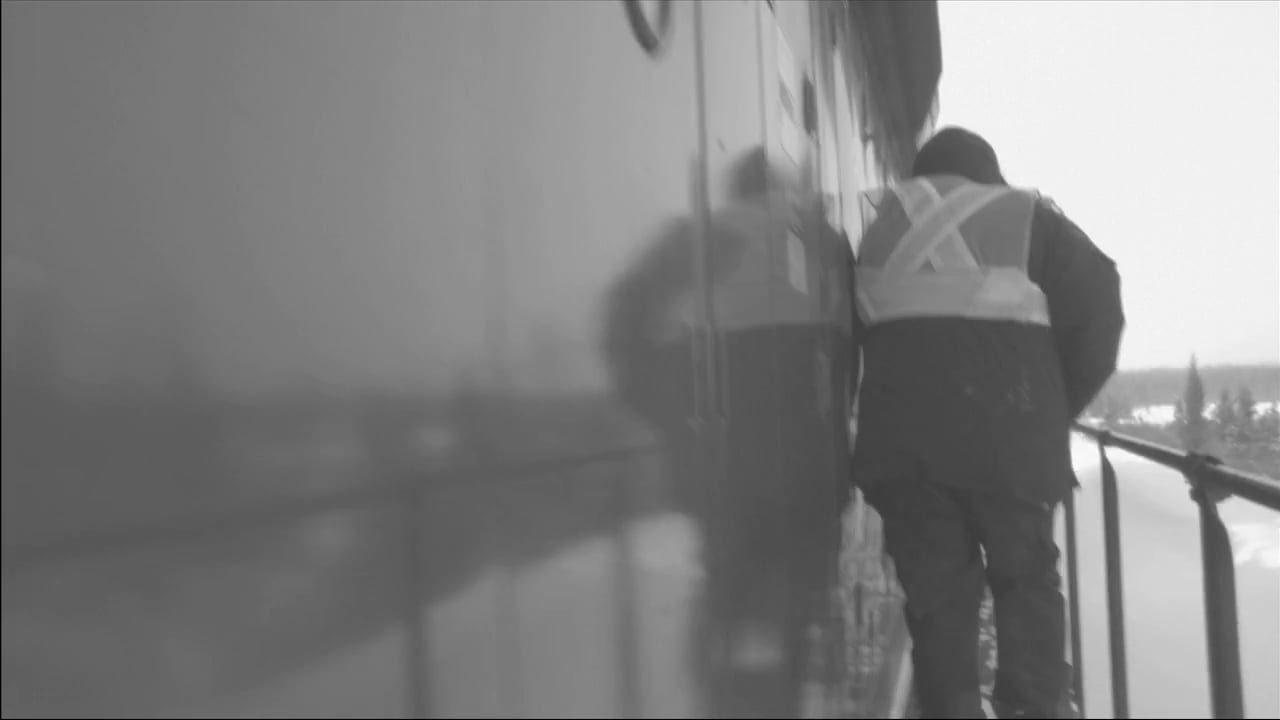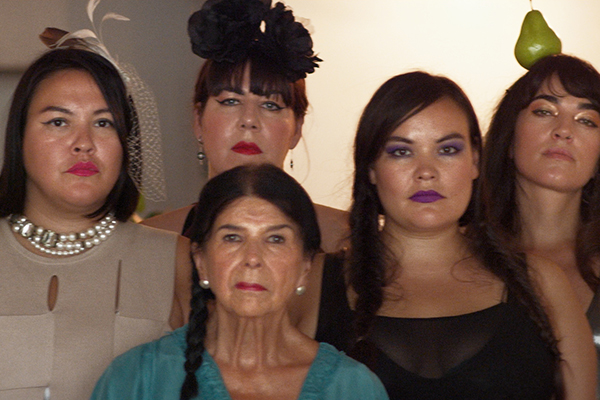This self-taught wonder has logged time in Winnipeg and Montreal, creating work that began as hand-made identity structures, black-and-white lyrics that lent style to her documentary leanings. She is Algonquin and French-Canadian, asymetrical facts that loom large in her making. Her hard work created new opportunities, but somehow the artist manages to navigate crews and collaborators while maintaining the necessary edge of her seeing, the urgent and devastating recall of Native history, the balm of beauty, and the troubling of any easy tags.
Ikwe 4:45 minutes 2009
An intimate family drama laid into the landscape of a face. What cannot be read there, shown there, what has not already been lived? Ikwe convenes a lunar compact with her grandmother and the moon in this luminously lyric short.
Amik(Waa) 6:50 minutes 2010
This is the stand-alone, single-channel version of what the artist has often exhibited as a full-scale installation, erecting a free-standing structure that is a revised version of “a traditional Shaking tent,” where her Algonquin shaman ancestors performed rites of divination. This movie is cast inside the structure, a quivering abstract whose floating lines are based on the sacred eight-pointed star. Shot in high-contrast black-and-white and multiply superimposed, abstract geometries collide and dissolve in an incantory dream dance. They might be Caligari outtakes, all ground and no figure, as the camera rises and falls in a paroxysm of presence. The sound was made in collaboration with Christian Richer.
Kwoni 2:32 minutes 2010
Smoky studio portraits of young Kimble Chartrand. Part of a trilogy of experimental docs (Warchild, Tashina) made about First Nations youth who board at South East Collegiate in Winnipeg.
Tashina 4:51 minutes 2010
Another gorgeoursly lensed documentary brief. Tashina Monias has left the reserve in order to come to a better school in Winnipeg. Broken phone calls home underline just how far away from home she is. Frozen wastes, a bridge crossing, the light in pine trees. Shots of the emptied school emphasize a geometry of repetitive order, a slightly menacing conformity where she appears as the only figure striding past the empty lockers, or else sitting between the library stacks while the camera slowly zooms away. Part of a trilogy of experimental docs (Warchild, Kwoni) made about First Nations youth who board at South East Collegiate in Winnipeg.
Warchild 5:43 minutes 2010
A lyric doc shot in the artist’s fave black and white frames. A single subject, a figure, is drawn against a ground of snow and forest and creek. He is making a trek, though it’s clear that home is out of the question. Who am I and where am I – the two questions blend. Projections abound (inside and out), the stake of the old pictures, the urgency of creating new ones. “I’ve learned that talking about things is much better than breaking a window.” Part of a trilogy of experimental documentaries (Kwoni, Tashina) made about First Nations youth who board at South East Collegiate in Winnipeg. Based on a story by Cody Pierre.
Gephyrophobia 2:18 minutes 2012
The title means fear of bridges, and the camera stands poised, or else races alongside the borders, of the boundary zone bridges that link English and French Canada, downtown Winnipeg and the North End, communities that are divided by, but also have in common, the Ottawa River. The artist’s strong frames and clear seeing propel these unpopulated gestures that redraw boundary lines even as it throws them into question.
“The bridge she is documenting in Gephyrophobia is between Hull, Ontario and Gatineau, Quebec…French and English Canada…but it immediately made me think of the cultural gap between Winnipeg and the North End on first viewing. Bridges that divide us.” Clint Enns
Demi Monde 3:29 minutes 2013
Another movie made at Phil Hoffman’s still ripening one-week film school adventure (aka Film Farm), the hand-processed high-contrast black-and-whites float across the landscape and beneath the waters, while the artist’s multiply-exposed face looks sternly towards a horizon she can’t touch yet. A trio of movie clips, contact printed using a home-made device, are gleaned from Pow Wow at Duck Lake (14:44 minutes 1967), a National Film Board film shot at Duck Lake, where a bevy of speakers sound off about Native schooling and youth opportunities. Demi Monde closes with a mirror laid into the landscape, a domestic version of Smithson perhaps, reminding us to keep the frame in mind. Who is being framed, in other words, who is being left out?
Lueur 11:05 minutes 2014
A-go-go visual patternings appear on two-screens for double the fun in a piece designed for looping outdoors. It begins with sober clouds drifting but these soon give way to a riot of digital recolourings, converting the natural world source material into a mirrored and kaleidoscopic abstract patterning.
Duo #1 3:13 minutes 2014
Made in colour in a single shot, two artists face to face, each blowing their amplified breath into transparent balloons. Is mine bigger than yours? Does your smallness make me bigger? Is love a zero sum game? Quite unlike anything else in her body of work (the flat video look of the thing, the real time, the performative nature, the art world remove…)
The artist notes: “Collaborative work created during Les Ateliers TD at Arsenal Montréal. March 2014. With Manuel Mathieu, Frances Adair McKenzie, Charles Lavoie, Guillaume Boudrias-Plouffe, Karine Payette.”
1701, Revisited 1 minute 2014
In a single frame, multiple archers gather in this time-staggered study. The target is off-screen, suggestive and multiplying. What isn’t being aimed at?
In 1701 the Great Peace of Montreal was signed, ending a century of war between the Iroquois Confederacy and New France (along with its Huron and Algonquin allies). The treaty ensured that the Iroquois would be on the sidelines for future hostilities, while Euro powers duked it out for the “new land.”
Portrait of an Indigenous Woman 16:05 minutes 2014
Ten women step into a studio, one at a time, to grant language to the question of what is an indigenous woman. It begins with a reading from The Odyssey, the ur-text of Western literature that describes the difficulties of returning home. The second speaker is concerned about exclusion (“other people are always trying to define you”), so she’s worried that indigeneous viewers will not be able to find necessary points of identification here in this video space. The third speaker talks about “culture days” at her grade school, where she she beads a Klingket garment. The fourth questions the notion of identity, and speaks about being two-spirited. The fifth and sixth speakers appear together, emphasizing how elusive and fragmentary the notion of identity is. “We have to break apart to come together.” The seventh speaker reads a text that identifies herself as queer, non-binary, Indian, artist, but feels they lack specificity. The eighth speaker speaks about her mother, role model and lineage keeper. The ninth speaker isn’t certain “indigeneous woman” is a category, she recalls her Cree-Metis mother and grandmother, and feels “maybe you have to be strong to be a woman at all.” The tenth woman reads in her native language. Alison Bremner, Leah Bromberg, Cassie Packham, Nicole Kelly Westman, Whess Marman, Patricia Livingston, Anne Riley, Gabrielle Hill, Caroline Monnet, Carola Grahn.
The Black Case 13 minutes 2014 (with Daniel Watchorn)
Shot in a fathomlessly deep noir palette, the artist brings us a long night at a boarding school for Native kids. The doctors are white monsters with unwanted touches and a mission from Jesus, the nightmares are snowbound, while each patient/child lies in a bricked up solitary where sick cries are met by songs of consolation until a final reckless judgement. Nearly wordless, the artists conjure a world of small gestures, a boy curling up on a bed, a woman lifting implements from a drawer, a death that tries to be small. Handsomely produced, with roles carved out for cast and costumes, the artist maintains her particular way of seeing, the money doesn’t turn the vision, but opens newly accessible forms.
Roberta 9 minutes 2014
In order to get ready for the party why not swallow a couple of those pills that lie waiting in the baggie underneath the furniture cushions, then dance with the vacuum cleaner while cleaning the rug? Roberta gags around with her little boy until she becomes a child too, which scares the shit out of her kid. The primal dance, the oldest feelings, the temporary joy of being stoned. Motherhood lasts such a long time. Then the trees come to life and swallows her breath until the people on her clothesline stop turning in the wind. The mirror is no one’s friend, but it can’t stop showing the pain. In the grip of her nervous breakdown, fuelled by pills and the boredom of a new day, Roberta tries to wrestle herself back into the ordinary life she was supposed to embrace, that she said yes to without realizing the cost. And then his voice offscreen, back from the straight world. Daddy’s home.
Light 1:37 minutes 2014
A fast-motion short finds the artist shedding light and casting shadows, returning us to the origins of cinema.
Mobilize by Caroline Monnet 3 minutes 2015
An exhilarating rush of a trip, the artist mobilizes the archives of the National Film Board in order to produce a trek from Canada’s northern reaches to the cities in the south. Every shot is a wonder, as Monnet reframes the archive with an aboriginal lens, allowing snowshoers, paddlers, strollers and iron walkers to cross the new screen of the eye. The score is by Polaris winner Tanja Tagaq.
Tshiuetin 10 minutes 2016
The artist takes us on a trip on the first Indigenous-owned train service (Tshiuetin means “north wind”) in Canada, running in northern Quebec. Using a deft series of musical interludes and spoken word recounts by the train’s conductor, she manages a portrait of the land that is also a return to identity and origins. Beautifully composed as usual, her camera work comes straight from her heart.
Creatura Dada 3 minutes 2016
They gather round the table to eat peaches and fish and string beans, wearing their out-of-this-world finery while the camera swishes and swoons between moments of abundance. Six indigeneous women dip into the oyster plate as the electroacoustic sound storm rolls past what is either the last supper or the first one. Featuring Alanis Obomsawin, Nadia Myre, Emilie Monnet, Swaneige Bertrand, Nahka Bertrand, Stefan St. Laurent. Produced for the 45th edition of the Festival du nouveau cinéma in Montreal, October, 2016.
